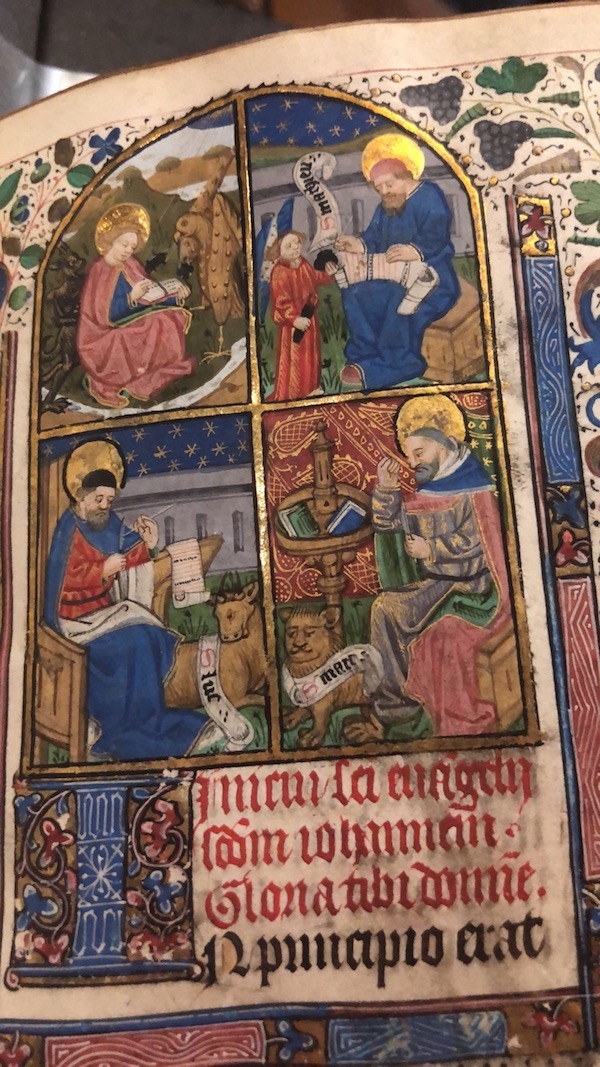
Portrait of the Four Evangelist, a Book of Hours. Rouen, France, about 1400-1499. UCLA Special Collections, Belt MS 37.
Portrait of the Four Evangelist, 1400-1499
This particular image comes from a book of hours. A book of hours is a Christian devotional book that contains psalms, prayers, and sometimes gospels. Popular in the medieval period, books of hours varied on what they contained. As each of these books was commissioned by specific patrons, the contents largely depended on the specific interests of those patrons within a religious context.
The book of hours shown here is known as the Belt MS 37, it is an illuminated manuscript that is held in the Special Collections of Young Research Library at UCLA. This book was written and illuminated in the 15th century in Rouen, France.
In this particular illumination, all four evangelists are represented along with their specific iconographic emblems. On the top left corner we have Saint John, below him is Saint Luke, in the top right corner we have Saint Matthew, and in the bottom right corner is Saint Mark.
The symbolic representations of the four evangelists have existed since early Christianity. The first time that these zoomorphic representations are heard of and seen is by the prophet Ezekiel around 590 to 570 BC. Ezekiel has a vision by the river of Chebar and sees a man, an eagle, a lion, and a bull. The allegorical imagery remained obscure until Saint John’s apocalyptic vision, elaborated in the book of Revelations, elucidated the meanings. After this we see the integration of these symbols introduced into illuminations used for gospel books from the seventh century onward.
The iconographies of the images of the four evangelists are specific. The representation of Saint Matthew is a man. The eagle is a portrayal of Saint John. The lion is an effigy of Saint Mark. While Saint Luke is embodied as an ox. It is believed that these symbols were chosen to epitomize specific characteristics of each evangelist’s gospel.
In this folio, we can identify each of the saints by the animal that sits beside them. As stated earlier, Saint John is on the top left corner, we know this because an eagle sits beside him as he crouches down to read a book. Below him is Saint Luke, who is seated with an ox at his feet.
On the top right corner, Saint Matthew is shown sitting down with a scroll on his lap, while a small man is visibly seen beside him. Finally, we have Saint Mark looking at books, with a lion at his feet. In closing knowing the iconographic emblems of each evangelist allows the reader to understand what they are looking at, and provides an idea of what the patron of this book of hours was interested in.
References
For more information on the representation of the four evangelists please refer to these sources.
Reference: Zofia Ameisenowa. "Animal-Headed Gods, Evangelist, Saints and Righteous Men." Journal of the Warburg and Courtauld Institutes 12,(1949): 21-45.
Reference: J. A. Herbert. "The Emblems of the Evangelists." The Burlington Magazine for Connoisseurs 13, No. 63 (1908): 162-167.
Reference: Emile Mâle. The Gothic Image: Religious Art in France of the Thirteenth Century. New York: Harper & Row, 1958.
This spotlight exhibit by Graciela Ramirez as part of Dr. Johanna Drucker's "History of the Book and Literacy Technologies" seminar in Winter 2018 in the Information Studies Department at UCLA.
For documentation on this project, personnel, technical information, see Documentation. For contact email: drucker AT gseis.ucla.edu.